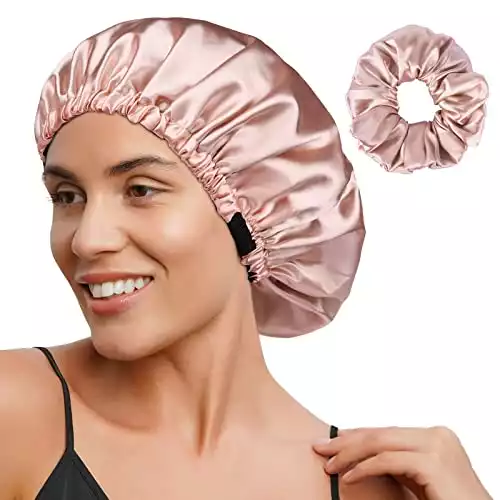Jump to:
Have you ever wondered how to wear a bonnet? For decades, women from the black community have worn bonnets. Today, this simple hair accessory has crossed ethnic boundaries and is worn by anyone, including men! Read on to find out how to wear a bonnet and more.
How to Wear a Bonnet: A Step-by-Step Guide
Here’s a simple rundown of how to wear a bonnet:
- Open the bonnet.
- Flip it over and insert your hair.
- Draw the band to secure the bonnet over your hair.
Contrary to many people’s opinions, people with bone straight hair can wear bonnets too. Bonnets are essential accessories women and men generally wear to protect their hair. A bonnet is a valuable tool for anyone with hair.
This fact is irrespective of race, ethnicity, gender, or hair type. Different curl patterns come with a different set of demands. Bottom line, if you want to maintain optimum hair health and achieve incredible length, you need a bonnet.
You probably are an avid bonnet user. But are you wearing your bonnet properly? Most people who wear bonnets don’t know how to do so correctly. So, to eliminate all guesswork, here’s a step-by-step guide on correctly wearing a bonnet.
Read Next: 15 Tips to Use When Caring for Natural Hair
Learn How to Wear a Bonnet in 3 Easy Steps
It’s a simple habit, but you’ll not benefit from wearing a bonnet if you do it wrong. Here are the steps you should follow to put on a bonnet like a pro.
Hold It Open
This step is the most straightforward. All you need to do is spread your fingers inside the bonnet and hold it open in front of you.
Flip It Over
Next, you’ll want to flip the bonnet over to the back of your hair. Then lean backward and gather all your hair inside. This step may take a few attempts to get right, but practice makes perfect!
Use a Mirror
If you’re not used to using a bonnet, it helps to stand in front of the mirror. This way, you can see if some of your hair is left peeking out.
Close the Bonnet
Draw the band to circle the perimeter of your hairline and secure it well enough to avoid slipping off during sleep. Give it a few light tugs to see if it needs to be put on again.
How to Wear a Bonnet on Straight Hair
Unlike curly or wavy hair, straight hair seems easy to maintain. After all, it’s easy to comb and doesn’t tangle. But, failure to practice hair care at home means that your straight hair will thin out, you’ll experience massive shedding, and grapple with annoying split ends.
These issues will hinder you from donning a full head of bouncy, lustrous tresses. Here’s how to wear a bonnet on straight hair:
- Hold your open bonnet facing you.
- Bend over all the way forward, so your hair hangs down towards your toes.
- Hold your open bonnet at the end of your hair and, like a sock, move the bonnet towards the back of your head until you reach the nape of your neck.
- Ensure all the hair is inside the bonnet, and no hair is left peeking out of the bonnet.
- In the same bent position, tighten the bonnet band and stand back up again to adjust the bonnet as desired.
How to Keep a Bonnet From Coming Off at Night
Having trouble keeping your bonnet in place through the night? It’s not unusual for you to have no trace of your bonnet in the morning, yet you remember putting it on before snuggling in bed.
Once or twice, it happens. But if your bonnet keeps coming off at night, you’ll hardly enjoy the benefits of using it in the first place.
Here’s how to avoid losing your bonnet during sleep:
- Get the right-sized bonnet
- Tie it tighter
- Secure your bonnet with hair clips
You could also tie a scarf on top of your bonnet to keep it in place. Just remember not to tie it too tight.
Hair growth depends on adequate blood supply. If you tie your bonnet too tight, this will cause hair loss on your hairline and limit blood circulation to your hair, which can curtail hair health and growth.
How to Find the Right Bonnet
Great selection. Even better prices. Shop bonnets today.
Not all bonnets are the same. Bonnets come in different sizes, materials, and designs. If you pick the proper bonnet, there’s no end to the magnitude of benefits your hair will reap. But do you know how to choose a bonnet? Below are some pointers on finding the right bonnet.
Material
A high-quality bonnet is made from smooth and slippery material. Most bonnets you’ll see are either made of satin or silk. Cotton bonnets tend to snag on your hair, creating knots and causing so much friction leading to breakage.
Bonnet Size
The size of your head and the bulk of your hair are significant factors that influence the bonnet size you should choose. Larger-sized bonnets tend to have big bands that barely keep them in place at night.
Bonnet Style
Bonnets come in various styles, including extra-large bonnets to accommodate huge afros, ones with adjustable elastic bands, and bonnets that have no adjustments. Choose a style that makes you feel comfortable and meets your needs.
The Benefits of Wearing a Bonnet the Right Way

Yaw Niel/Shutterstock
Once you put on a bonnet and get a feel of how helpful it is for your hair, there’s no going back. Bonnets play an integral role in keeping your hair healthy. They help your hair:
- Retain moisture
- Prevent frizz
- Reduce oil
Retaining hair shine, length, and strength is no easy feat. You may probably wonder what all the fuss on bonnets is about. Here are the reasons people swear by their bonnets with such unwavering confidence.
Prevents Tangling
Part of sleeping involves tossing and turning, trying to find the best position. Without a bonnet, your hair is left exposed and vulnerable to tangling and split ends, ultimately leading to hair breakage. When you wear a bonnet, your hair remains intact.
Read Next: How to Detangle Matted Hair
Locks in Moisture
Like a twig, hair becomes dry and breaks when it loses moisture. Dry hair is the most likely to suffer damage. A satin bonnet is made of breathable fabric that helps retain our hair’s moisture.
Promotes Optimum Product Absorption
Leave-in conditioners, hot oil treatments, and hair serums need time to penetrate the hair follicles to help strengthen and restore your hair. When doing such treatments, putting on a bonnet allows the products to slowly absorb into your hair without transferring onto the pillow.
Thanks to the bonnet, your goal of having lustrous hair is possible because you use less heat and protect your hair from external damaging factors.
Protects Your Hair Style
If you just had your hair done, you want to maintain the hairdo for as long as possible without your hair losing shape. A bonnet helps protect your hairstyle by keeping your hair intact and minimizes hair movement during sleep.
When you wake up and remove the bonnet, your curls appear fresh, and you’re ready to go in no time.
Reduces Frizz
Frizz is the absolute killjoy for anyone with hair on their head. It looks unpresentable and makes you feel unkempt. Even with minimal twisting and turning at night, your hair tends to absorb moisture from the air.
Rubbing your head on the pillow turns humid hair into tiny knots that make combing your hair in the morning a nightmare. A silk bonnet is an inexpensive accessory you can use to prevent frizz, knotting, and hair thinning.
Read Next: How to Get Rid of Frizzy Hair
Better Skin
Without a bonnet, natural hair oils, styling products, and your hair rub on your pillow and skin. Everything that goes on your pillow can access the skin on your face, neck, chest, and upper back.
The result is clogged pores and skin irritation, which leads to pimple breakouts, skin aging, and other irregularities. With a bonnet, you never have to worry about bad skin. The hair and all its products stay away from your pillow and off your skin.
Saves You Money
Bonnets are the unsung heroes of the hair accessory industry. If you habitually put on bonnets, you’ll go to your stylist less often because your hair will remain manageable for longer. It also becomes easier to do your hair at home. Essentially, you save more money.
Frequently Asked Questions
If you’ve ever wondered how to wear a bonnet, you might have a few more questions. Below are the answers to all your bonnet-related questions.
Should you wear a hair bonnet over your ears?
Whatever works for you. Some people like to cover their ears under their bonnets; others prefer to leave their ears out. Most people prefer to leave their ears out to avoid stretching out the elastic band.
On the other hand, a small fraction will tuck their ears under their bonnets to relieve the pressure when they fit their bonnet tight to avoid slipping off.
Are bonnets ideal for all hair types?
People with straight, wavy, curly, and kinky textures stand to benefit from wearing bonnets. Irrespective of your curl pattern, your hair is vulnerable to tangling, frizzing, and breakage if you prefer to sleep without a bonnet.
It matters not your hair type; a bonnet is incredibly beneficial for you. You’ll realize significant hair growth and optimum hair health if you have a habit of wearing bonnets.
Scarf or bonnet, which is best?
Most scarfs are made from cotton material. Cotton isn’t the best for your hair, especially when you’re trying to retain moisture and avoid friction on your hair.
If you find a silk or satin scarf, you can tie it properly on your head and use it in place of a bonnet. A bonnet is better because it’s explicitly designed to conceal and protect your hair.
Should I choose a silk or satin bonnet?
It’s up to you which material you decide. Both satin and silk bonnets prevent hair damage and maintain moisture. However, each type of material has a unique set of benefits.
Silk is more environmentally friendly and breathable, allowing for better temperature regulation. But, it’s also more expensive and harder to find. On the other hand, synthetic satin lasts longer and is smoother.
Should I wear a bonnet every night?
It’s good practice to keep your bonnet on every night. One night without your bonnet means your hair is vulnerable to damaging factors, such as split ends, dryness, tangling, and breakage.
Final Thoughts: How Do You Wear a Bonnet?
Now you know how to wear a bonnet to protect your hair from damage and moisture loss. Bonnets are a fantastic hair accessory that anybody can use. Cheers to the healthiest, most lustrous mane ever. Happy styling!

